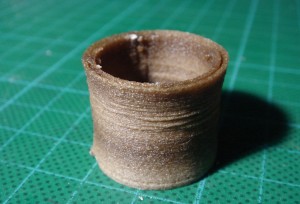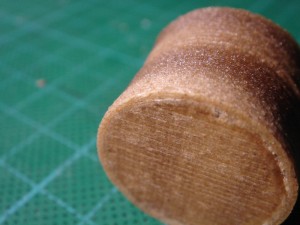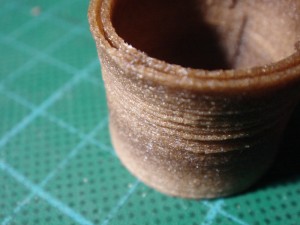Printing with Wood Composite
The recent articles (3ders, Thingiverse) about printing with "wood" piqued my interest, and I was excited to see the GRRF sells 0.5kg rolls. It seems I submitted my order in time because they are now out of stock - but taking pre-orders. The filament arrived today and I got a chance to make a test print - the trusty, if now unoriginal, minimug.
The GRRF page and the original Thingiverse entry by Kaipa state that it's warp-free and requires no heated bed, so I gave this a try and true enough it printed out perfectly. The hot-end was set to 190°C at the start, and I manually increased the temperature in 10° increments to 220°C back and forth to produce the colour gradient.
The bottom of the print is smooth, similar to the finish from PLA, whereas the sides and top are rougher. So far I haven't attempted working with it (drilling, cutting, etc), which I will try tomorrow. I did try a little sanding which required a bit more effort than real wood and again was similar to working with PLA. I'll be interested to see how well it takes paints and lacquers.
I find this development pretty exciting as it opens up another material that works immediately with a reprap FDM printer. Kaipa isn't revealing what is in the composite, nor his process, but Viktor from the forums pointed out a material from Tecnaro called Arboform. This thermoplastic composite is based on Lignin, a natural polymer, which is a by-product of the pulp industry.
"Mixing lignin with natural fibres (flax, hemp or other fibre plants) and some natural additive produces a fibre composite that can be processed at raised temperatures and, just like a synthetic thermoplastic material, can be made into mouldings, plates or slabs on conventional plastics processing machines."
What's also really interesting is seeing the other products from Tecnaro: Arbofill and Arboblend. The latter having comparable properties to ABS, apparently.
I believe Tecnaro only sells granules, and cater for manufacturers, as their minimum order quantity is 25kg (1 bag) but considering the recent arrival of filament extruders (Lyman, Filabot) it seems it would be a perfect match for the 3D printing community. Anyone in Germany (Baden-Württemberg) want to split a 25kg bag with me?
... and of course the minimug was watertight!
Comments
-
AndyP
25-09-2012 17:19
I really like the gradient wood color look. What size nozzle are you using? Would a 0.35mm work? What type of hot end?
-
Gary Hodgson
25-09-2012 20:13
Hi, I'm using a 0.5mm nozzle with a homebrew, but standard, hotend (alu block, brass nozzle, peek insulator) I guess a 0.35mm nozzle would work fine. I always had problems with my 0.35mm and PLA, but I think that is due to the design more than anything. I'm going to write up more on how the wood composite is to work with but I can say it is like slightly spongy PLA, and extrudes very easily at a range of temperatures. In fact it extrudes a little too easily and I had to modify my retract settings a little.
-
RichRap
27-09-2012 10:46
Hi Gary,
Nice test, I was going to order some, and I wish I had, the price has now gone up and it's now only 250g rolls :(
Maybe we will have more sources soon and the price will lower again.
Can it be dissolved in any way? for use as a support material?
What happens if you run it at a much higher temperature? Any bubbles? I was wondering if you could make a wood-foam structure using elevated temp.
I also wonder what other materials can be mixed with PLA...???
-
Wood composite 3D printing filament in action « Ponoko – Blog
27-09-2012 11:37
[...] read the rest of Gary’s thoughts and see more photographs, check out his two blog posts here: http://garyhodgson.com/reprap/2012/09/printing-with-wood-composite/ and here: [...]
-
Gary Hodgson
27-09-2012 12:11
Hi Rich, I didn't think about trying to dissolve it - I'll put it on my list. I'll also play with the temperature extremes.
I don't know if you've already seen this, but Tecnaro sent me a pdf brochure which gives an idea of what can be done with wood composites. I sent an email to their distributer (Albis) asking about filaments and smaller order quantities - let's hope they reply.
It seems this PLA/Lignum + X composite idea could yield some interesting materials. Exciting times!
-
RichRap
27-09-2012 12:54
Thanks Gary, Interesting indeed. We need a lot more polymer experimentation in RepRap. I really do like this one.
-
Alfred
02-10-2012 21:05
Hi Garry,
kaipi isn't telling us from grrf what the base material of LAY-WOOD is. He went up with the price a lot, arguing the the raw material is so expensive. We would be interested in your findings with the Tecnaro material.
regards,
Alfred
-
Gary Hodgson
02-10-2012 22:20
Hi Alfred, I just sent you an email with the details. Basically both Tecnaro, and their supplier Albis, only supply granules in 25kg bags. So if the material is suitable one would have to order a lot, and then create the filament oneself.
-
Chris Marion
26-10-2012 05:15
Gary,
If you're still interested in creating filament for this new material, perhaps my recent advances in filament extrusion would be helpful. Feel free to shoot me an email any time to discuss further!
-Chris
-
3D-Druck aus Holz – inklusive Maserung | real-digital
14-11-2012 12:45
[...] erster Erfahrungsbericht findet sich bei Gary Hodgson in seinem Blog. Getagged mit3D-Druck • Filament If you enjoyed this article, please [...]
-
3D Printing Materials: From Plastic to Metal to Wood and Beyond
13-05-2013 17:46
[...] to appeal on aesthetically as well as economically, a German company found a way to create printable wood. It’s made of wood fibers and a lignin based polymer that behaves similarly to plastic. Depending [...]
-
Pierre Baillargeon
03-07-2013 04:27
I just purchased some Laywoo-D3 1.75mm filament from Amazon and it works as you describe above. One thing that I noticed though is that the printed piece seems flexible, as if it needs to be cured. Did you have to let the prints dry out or cure them after printing at all?
-
Gary Hodgson
03-07-2013 09:04
Hi Pierre, Yes, the print is quite flexible directly after printing - I find it gets a little harder after a few hours, but it is definitely more flexible than PLA for example.
I haven't heard of anyone "curing" it at all. Although I am tempted to find some food-safe polyurethane paint to paint the prints with.
All the best,
Gary
-
Zatnik
14-12-2013 10:28
It works fine with a .4 mm nozzle



